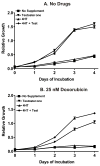Targeting the RAF/MEK/ERK, PI3K/AKT and p53 pathways in hematopoietic drug resistance
- PMID: 17382374
- PMCID: PMC2696319
- DOI: 10.1016/j.advenzreg.2006.12.013
Targeting the RAF/MEK/ERK, PI3K/AKT and p53 pathways in hematopoietic drug resistance
Figures















Similar articles
-
Roles of the Ras/Raf/MEK/ERK pathway in leukemia therapy.Leukemia. 2011 Jul;25(7):1080-94. doi: 10.1038/leu.2011.66. Epub 2011 Apr 15. Leukemia. 2011. PMID: 21494257 Review.
-
Dual Inhibition of PI3K-AKT-mTOR- and RAF-MEK-ERK-signaling is synergistic in cholangiocarcinoma and reverses acquired resistance to MEK-inhibitors.Invest New Drugs. 2014 Dec;32(6):1144-54. doi: 10.1007/s10637-014-0149-7. Epub 2014 Aug 26. Invest New Drugs. 2014. PMID: 25152244
-
Involvement of p53 and Raf/MEK/ERK pathways in hematopoietic drug resistance.Leukemia. 2008 Nov;22(11):2080-90. doi: 10.1038/leu.2008.207. Epub 2008 Aug 7. Leukemia. 2008. PMID: 18685611
-
Ras/Raf/MEK/ERK and PI3K/PTEN/Akt/mTOR inhibitors: rationale and importance to inhibiting these pathways in human health.Oncotarget. 2011 Mar;2(3):135-64. doi: 10.18632/oncotarget.240. Oncotarget. 2011. PMID: 21411864 Free PMC article. Review.
-
Ras/Raf/MEK/ERK and PI3K/PTEN/Akt/mTOR cascade inhibitors: how mutations can result in therapy resistance and how to overcome resistance.Oncotarget. 2012 Oct;3(10):1068-111. doi: 10.18632/oncotarget.659. Oncotarget. 2012. PMID: 23085539 Free PMC article. Review.
Cited by
-
OncomiRdbB: a comprehensive database of microRNAs and their targets in breast cancer.BMC Bioinformatics. 2014 Jan 15;15:15. doi: 10.1186/1471-2105-15-15. BMC Bioinformatics. 2014. PMID: 24428888 Free PMC article.
-
Diaporine Potentiates the Anticancer Effects of Oxaliplatin and Doxorubicin on Liver Cancer Cells.J Pers Med. 2022 Aug 16;12(8):1318. doi: 10.3390/jpm12081318. J Pers Med. 2022. PMID: 36013267 Free PMC article.
-
Targeting the PI3K/AKT/mTOR and RAF/MEK/ERK pathways for cancer therapy.Mol Biomed. 2022 Dec 21;3(1):47. doi: 10.1186/s43556-022-00110-2. Mol Biomed. 2022. PMID: 36539659 Free PMC article. Review.
-
Endothelial cell-derived interleukin-6 regulates tumor growth.BMC Cancer. 2014 Feb 17;14:99. doi: 10.1186/1471-2407-14-99. BMC Cancer. 2014. PMID: 24533454 Free PMC article.
-
Prostate cancer cells hyper-activate CXCR6 signaling by cleaving CXCL16 to overcome effect of docetaxel.Cancer Lett. 2019 Jul 10;454:1-13. doi: 10.1016/j.canlet.2019.04.001. Epub 2019 Apr 8. Cancer Lett. 2019. PMID: 30974114 Free PMC article.
References
-
- Abe J, Kusuhara M, Ulevitch RJ, Berk BC, Lee JD. Big mitogen-activated protein kinase 1 (BMK1) is a redox-sensitive kinase. J Biol Chem. 1996;271:16586–90. - PubMed
-
- Adachi T, Kar S, Wang M, Carr BI. Transient and sustained ERK phosphorylation and nuclear translocation in growth control. J Cell Physiol. 2002;192:151–59. - PubMed
-
- Aggerholm A, Gronbaek K, Guldberg P, Hokland P. Mutational analysis of the tumour suppressor gene MMAC1/PTEN in malignant myeloid disorders. Eur J Haematol. 2000;65:109–13. - PubMed
-
- Allan LA, Morrice N, Brady S, Magee G, Pathak S, Clarke PR. Inhibition of caspase-9 by phosphorylation at Thr125 by ERK MAP kinase. Nature Cell Biol. 2003;5:647–54. - PubMed
Publication types
MeSH terms
Substances
Grants and funding
LinkOut - more resources
Full Text Sources
Research Materials
Miscellaneous

